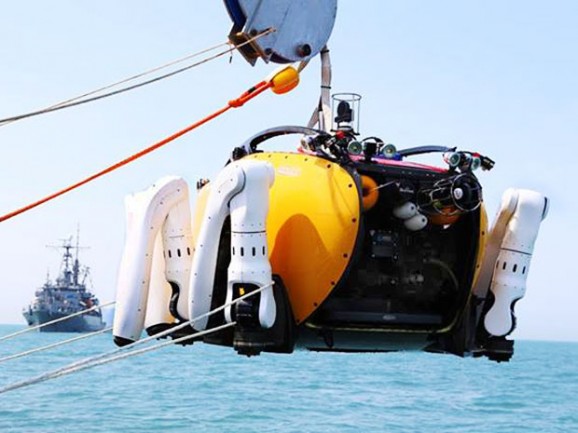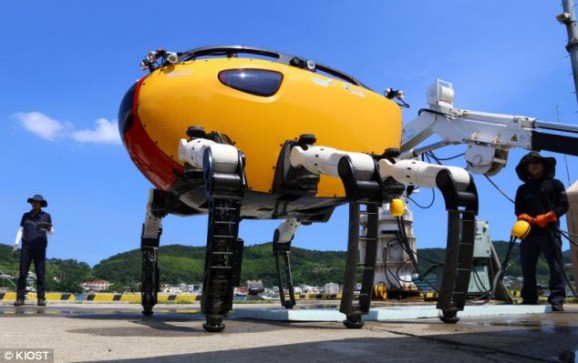Robotic Crabster Joined South Korean Ferry Rescue Operation
This article is more than 2 years old
 About six weeks ago, GFR reported on the Crabster, a gigantic robotic crab developed by the Korean Institute of Ocean Science and Technology (KRISO) for deep and dangerous underwater exploration. Given that Crabster began to undergo testing only a year ago, not even its developers expected to use it in a real-world scenario just yet. But sometimes planning and expectations are irrelevant, especially when something horrible happens, like a ferry sinking in South Korea.
About six weeks ago, GFR reported on the Crabster, a gigantic robotic crab developed by the Korean Institute of Ocean Science and Technology (KRISO) for deep and dangerous underwater exploration. Given that Crabster began to undergo testing only a year ago, not even its developers expected to use it in a real-world scenario just yet. But sometimes planning and expectations are irrelevant, especially when something horrible happens, like a ferry sinking in South Korea.
One of the developers at KRISO, Bong-Haun Jun, observed the difficulties encountered by the rescue team—namely, strong currents and murky waters. After reviewing all of the underwater robots KRISO could lend to the rescue offered, eventually decided that Crabster would be the most helpful. The Sewol ferry sunk on April 16, and after four days of difficult and frustrating rescue operations, the South Korean government sought Crabster. The giant robot was moved to Jindo Island the next day, joining a dozen ships and smaller boats working in the area. Divers headed down about 45 meters, but at that depth had a visibility of only roughly 20 centimeters, while currents moving about 15 kilometers an hour tossed them around. The strength of those currents are three times greater than the tests Crabster withstood.
 Because of its new and relatively untested status, and because Crabster couldn’t navigate the sunken vessel itself, the South Korean Coast Guard wouldn’t allow the robot to work with the human divers, as it is optimally designed to do. But they did allow the device to dive 70 meters to survey the ship for roughly 90 minutes. Even so, it was tough going. The weather was uncooperative, and the team spent much of their time waiting for it to get better. Eventually, Crabster followed up its initial dive with a dozen more, spending a grand total of 15.5 hours underwater.
Because of its new and relatively untested status, and because Crabster couldn’t navigate the sunken vessel itself, the South Korean Coast Guard wouldn’t allow the robot to work with the human divers, as it is optimally designed to do. But they did allow the device to dive 70 meters to survey the ship for roughly 90 minutes. Even so, it was tough going. The weather was uncooperative, and the team spent much of their time waiting for it to get better. Eventually, Crabster followed up its initial dive with a dozen more, spending a grand total of 15.5 hours underwater.
Crabster successfully navigated the currents, as well as the mud, stones, and other debris at the bottom of the ocean. Its camera and sonar capabilities also worked perfectly and helped map out the wreck. The team remained for almost a month, and despite the information it gathered, neither they nor the robot could do anything about the devastating death toll. Still, Crabster’s inaugural mission won’t be its last, especially as it seems to have garnered some trust from the South Korean government. The KRISO team hopes to make the next version hydraulic-powered, which would allow it to “break the doors and windows” of sunken ships, as well as “install guide ropes and make routes to inside the ferry for divers at the initial rescue stage.”
Here’s hoping that Crabster isn’t needed again anytime soon, but when it is, it sounds like it will be more than ready.












